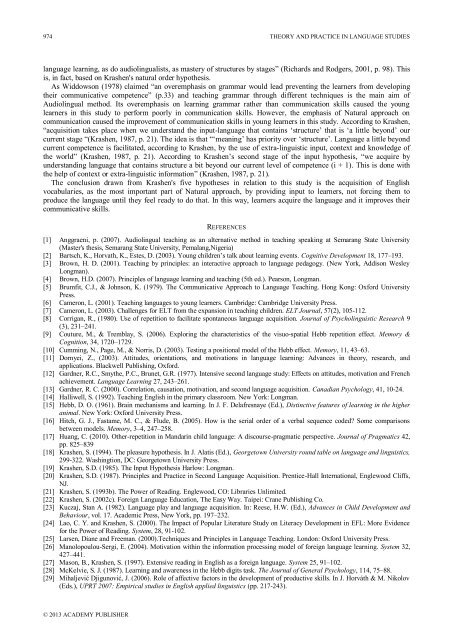Theory and Practice in Language Studies Contents - Academy ...
Theory and Practice in Language Studies Contents - Academy ...
Theory and Practice in Language Studies Contents - Academy ...
Create successful ePaper yourself
Turn your PDF publications into a flip-book with our unique Google optimized e-Paper software.
974 THEORY AND PRACTICE IN LANGUAGE STUDIESlanguage learn<strong>in</strong>g, as do audiol<strong>in</strong>gualists, as mastery of structures by stages” (Richards <strong>and</strong> Rodgers, 2001, p. 98). Thisis, <strong>in</strong> fact, based on Krashen's natural order hypothesis.As Widdowson (1978) claimed “an overemphasis on grammar would lead prevent<strong>in</strong>g the learners from develop<strong>in</strong>gtheir communicative competence” (p.33) <strong>and</strong> teach<strong>in</strong>g grammar through different techniques is the ma<strong>in</strong> aim ofAudiol<strong>in</strong>gual method. Its overemphasis on learn<strong>in</strong>g grammar rather than communication skills caused the younglearners <strong>in</strong> this study to perform poorly <strong>in</strong> communication skills. However, the emphasis of Natural approach oncommunication caused the improvement of communication skills <strong>in</strong> young learners <strong>in</strong> this study. Accord<strong>in</strong>g to Krashen,“acquisition takes place when we underst<strong>and</strong> the <strong>in</strong>put-language that conta<strong>in</strong>s „structure‟ that is „a little beyond‟ ourcurrent stage “(Krashen, 1987, p. 21). The idea is that “„mean<strong>in</strong>g‟ has priority over „structure‟. <strong>Language</strong> a little beyondcurrent competence is facilitated, accord<strong>in</strong>g to Krashen, by the use of extra-l<strong>in</strong>guistic <strong>in</strong>put, context <strong>and</strong> knowledge ofthe world” (Krashen, 1987, p. 21). Accord<strong>in</strong>g to Krashen‟s second stage of the <strong>in</strong>put hypothesis, “we acquire byunderst<strong>and</strong><strong>in</strong>g language that conta<strong>in</strong>s structure a bit beyond our current level of competence (i + 1). This is done withthe help of context or extra-l<strong>in</strong>guistic <strong>in</strong>formation” (Krashen, 1987, p. 21).The conclusion drawn from Krashen's five hypotheses <strong>in</strong> relation to this study is the acquisition of Englishvocabularies, as the most important part of Natural approach, by provid<strong>in</strong>g <strong>in</strong>put to learners, not forc<strong>in</strong>g them toproduce the language until they feel ready to do that. In this way, learners acquire the language <strong>and</strong> it improves theircommunicative skills.REFERENCES[1] Anggraeni, p. (2007). Audiol<strong>in</strong>gual teach<strong>in</strong>g as an alternative method <strong>in</strong> teach<strong>in</strong>g speak<strong>in</strong>g at Semarang State University(Master's thesis, Semarang State University, Pemalang,Nigeria)[2] Bartsch, K., Horvath, K., Estes, D. (2003). Young children‟s talk about learn<strong>in</strong>g events. Cognitive Development 18, 177–193.[3] Brown, H. D. (2001). Teach<strong>in</strong>g by pr<strong>in</strong>ciples: an <strong>in</strong>teractive approach to language pedagogy. (New York, Addison WesleyLongman).[4] Brown, H.D. (2007). Pr<strong>in</strong>ciples of language learn<strong>in</strong>g <strong>and</strong> teach<strong>in</strong>g (5th ed.). Pearson, Longman.[5] Brumfit, C.J., & Johnson, K. (1979). The Communicative Approach to <strong>Language</strong> Teach<strong>in</strong>g. Hong Kong: Oxford UniversityPress.[6] Cameron, L. (2001). Teach<strong>in</strong>g languages to young learners. Cambridge: Cambridge University Press.[7] Cameron, L. (2003). Challenges for ELT from the expansion <strong>in</strong> teach<strong>in</strong>g children. ELT Journal, 57(2), 105-112.[8] Corrigan, R., (1980). Use of repetition to facilitate spontaneous language acquisition. Journal of Psychol<strong>in</strong>guistic Research 9(3), 231–241.[9] Couture, M., & Tremblay, S. (2006). Explor<strong>in</strong>g the characteristics of the visuo-spatial Hebb repetition effect. Memory &Cognition, 34, 1720–1729.[10] Cumm<strong>in</strong>g, N., Page, M., & Norris, D. (2003). Test<strong>in</strong>g a positional model of the Hebb effect. Memory, 11, 43–63.[11] Dornyei, Z., (2003). Attitudes, orientations, <strong>and</strong> motivations <strong>in</strong> language learn<strong>in</strong>g: Advances <strong>in</strong> theory, research, <strong>and</strong>applications. Blackwell Publish<strong>in</strong>g, Oxford.[12] Gardner, R.C., Smythe, P.C., Brunet, G.R. (1977). Intensive second language study: Effects on attitudes, motivation <strong>and</strong> Frenchachievement. <strong>Language</strong> Learn<strong>in</strong>g 27, 243–261.[13] Gardner, R. C. (2000). Correlation, causation, motivation, <strong>and</strong> second language acquisition. Canadian Psychology, 41, 10-24.[14] Halliwell, S. (1992). Teach<strong>in</strong>g English <strong>in</strong> the primary classroom. New York: Longman.[15] Hebb, D. O. (1961). Bra<strong>in</strong> mechanisms <strong>and</strong> learn<strong>in</strong>g. In J. F. Delafresnaye (Ed.), Dist<strong>in</strong>ctive features of learn<strong>in</strong>g <strong>in</strong> the higheranimal. New York: Oxford University Press.[16] Hitch, G. J., Fastame, M. C., & Flude, B. (2005). How is the serial order of a verbal sequence coded? Some comparisonsbetween models. Memory, 3–4, 247–258.[17] Huang, C. (2010). Other-repetition <strong>in</strong> M<strong>and</strong>ar<strong>in</strong> child language: A discourse-pragmatic perspective. Journal of Pragmatics 42,pp. 825–839[18] Krashen, S. (1994). The pleasure hypothesis. In J. Alatis (Ed.), Georgetown University round table on language <strong>and</strong> l<strong>in</strong>guistics,299-322. Wash<strong>in</strong>gtion, DC: Georgetown University Press.[19] Krashen, S.D. (1985). The Input Hypothesis Harlow: Longman.[20] Krashen, S.D. (1987). Pr<strong>in</strong>ciples <strong>and</strong> <strong>Practice</strong> <strong>in</strong> Second <strong>Language</strong> Acquisition. Prentice-Hall International, Englewood Cliffs,NJ.[21] Krashen, S. (1993b). The Power of Read<strong>in</strong>g. Englewood, CO: Libraries Unlimited.[22] Krashen, S. (2002c). Foreign <strong>Language</strong> Education, The Easy Way. Taipei: Crane Publish<strong>in</strong>g Co.[23] Kuczaj, Stan A. (1982). <strong>Language</strong> play <strong>and</strong> language acquisition. In: Reese, H.W. (Ed.), Advances <strong>in</strong> Child Development <strong>and</strong>Behaviour, vol. 17. Academic Press, New York, pp. 197–232.[24] Lao, C. Y. <strong>and</strong> Krashen, S. (2000). The Impact of Popular Literature Study on Literacy Development <strong>in</strong> EFL: More Evidencefor the Power of Read<strong>in</strong>g. System, 28, 91-102.[25] Larsen, Diane <strong>and</strong> Freeman. (2000).Techniques <strong>and</strong> Pr<strong>in</strong>ciples <strong>in</strong> <strong>Language</strong> Teach<strong>in</strong>g. London: Oxford University Press.[26] Manolopoulou-Sergi, E. (2004). Motivation with<strong>in</strong> the <strong>in</strong>formation process<strong>in</strong>g model of foreign language learn<strong>in</strong>g. System 32,427–441.[27] Mason, B., Krashen, S. (1997). Extensive read<strong>in</strong>g <strong>in</strong> English as a foreign language. System 25, 91–102.[28] McKelvie, S. J. (1987). Learn<strong>in</strong>g <strong>and</strong> awareness <strong>in</strong> the Hebb digits task. The Journal of General Psychology, 114, 75–88.[29] Mihaljević Djigunović, J. (2006). Role of affective factors <strong>in</strong> the development of productive skills. In J. Horváth & M. Nikolov(Eds.), UPRT 2007: Empirical studies <strong>in</strong> English applied l<strong>in</strong>guistics (pp. 217-243).© 2013 ACADEMY PUBLISHER
















